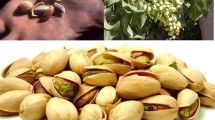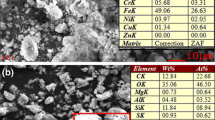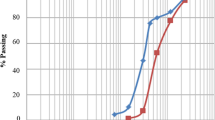Abstract
Sewage sludge is one of the largest contributors toward solid waste in Malaysia. The amount of sewage generated is expected to increase every year, which is in line with the population growth in Malaysia. Landfilling has been identified to be the most widely used method to dispose of sewage sludge in Malaysia. This high amount of solid waste resulted in shortage of landfilling area, which has indirectly increased the cost of waste management in Malaysia. Hence, the aim of this chapter is to identify the potential use of solid wastes; namely sewage sludge and eggshell as partial cement replacement in mortar bricks. The sewage sludge and eggshell wastes were obtained from Indah Water Konsortium (IWK) and Eggtech Manufacturing, respectively. Both sewage sludge and eggshell powder were treated prior to mixing. The organic materials in the sewage sludge were removed through incineration process at a temperature of 800 °C for 3 h in which Incinerated Sewage Sludge Ash (ISSA) was produced. Meanwhile, the eggshell waste was dried under the sun before being ground into powder form. The treated ISSA and eggshell powder were then mixed with Ordinary Portland Cement, fine aggregates, and water to produce mortar bricks. Tests including compressive strength, flexural strength, and water absorption were conducted on bricks formed from four different percentages of eggshell powder (5–20%) with 10% ISSA. Findings showed that 10% ISSA as partial cement replacement with 5% eggshell as additive has increased the strength of the mortar bricks tested to 72% higher than the strength of the control bricks.
Access provided by CONRICYT-eBooks. Download conference paper PDF
Similar content being viewed by others
Keywords
1 Introduction
Sewage sludge is a semisolid material, also referred to as biosolids, that is, the by-product of sewage treatment plants. It contains mineral, organic, and biological impurities in soluble, insoluble, and colloidal form. Indah Water Konsortium (2010) estimated the population of Malaysia to be 32.4 million in 2020 and 36 million by 2030. The increase of population will directly increase the generation of sewage sludge. An annual estimate of 7 million cubic metres of sewage sludge will be produced in the year 2020 and this is recorded by Indah Water Konsortium (2010). It is estimated that approximately 1.7 million tonnes of incinerated sewage sludge is produced annually worldwide and the amount is likely to increase in the future. The best way to recycle the nutrients and organic matters contained in sewage sludge is through the utilization of land (Sanchez-Monedero et al. 2004).
In the past, sewage sludge has been used as fertilizer in agriculture. Unfortunately, Hsiau and Lo (1998) and, more recently, Herzel et al. (2016) discovered the occurrence of high heavy metal in sewage. Concerns had been increased toward the exposure of emerging pollutants such as metals, organic contaminants and pathogenic bacteria in sewage sludge as these might threaten human health through crops cultivated in sewage or compost-amended soils (Zuloaga et al. 2012).
Eggshell is rich in calcium carbonate, CaCO3, which makes up about 94% of the shell (Murakami et al. 2007). Eggshell is known to have potential to be mixed with cement-based material for strength and properties improvement. Tsai et al. (2007) suggested that eggshell is traditionally useless and is usually disposed in landfills without any pretreatment. Calcium carbonate, namely limestone, which contains calcite, is used as additive in concrete (Matschei et al. 2007). The presence of reactive calcite alters the mineralogy of hydrated cement paste.
Current research shows that the use of incinerated sewage sludge is very minimal, up to only 8% as cement replacement and 20% as cement additive. One of the methods which can be used to increase the use of incinerated sewage sludge is to include calcium carbonate. The typical calcium carbonate source used in the construction industry is limestone, which is a type of nonrenewable material obtained from quarrying. In this investigation, eggshell containing 95% calcium carbonate is used as additive to optimize the use of sewage sludge as cement replacement in concrete.
2 Materials and Methods
The materials used in the investigation were incinerated sewage sludge ash (ISSA), eggshell powder, ordinary Portland cement, fine aggregates, and water. The preparation of material such as ISSA and eggshell powder is further discussed in this section. Besides that, the standards used for all the experiments were also clearly defined.
2.1 Incinerated Sewage Sludge Ash (ISSA)
The sewage sludge used in this research was collected from an IWK sewage treatment plant (Fig. 1) located in Kuantan which caters to a commercial area. At the sewage treatment plant, the sewage sludge was sun-dried at the sludge bed. Once collected from the sewage treatment plant, the sewage sludge was oven-dried at 105 °C for 24 h to lower the moisture content of the sample before being sent for incineration at 800 °C for 3 h and 30 min. The product from the incineration process is known as ISSA. The ISSA is then cooled down to room temperature before being packed into sealable bags. Prior to mixing, the ISSA has to be ground into fine particles and sieved as only particles passing through 150 μm sieve were used in this research. Figure 2 shows the sample of ground ISSA.
2.2 Eggshell Powder
The eggshells used in this research were collected from Eggtech Manufacturing Sdn Bhd in Kuala Selangor. The eggshells were spread onto trays to be dried under the sun. The dried eggshells were then ground into powder using a grinder. The color of the ground eggshells is barley white as shown in Fig. 3.
2.3 Ordinary Portland Cement
The cement used in this research is YTL ORANG KUAT Ordinary Portland Cement (OPC). YTL ORANG KUAT is certified to MS 522-1: 2007 (EN 197-1: 2000), CEM I 42.5 N/52.5 N, and MS 522: Part 1:2003. This cement is widely used in Malaysia for construction work particularly in bricklaying, concreting, plastering, screeding, and tiling. In this research, only cement from the same batch was used to ensure the accuracy and consistency of the research.
2.4 Fine Aggregate
The fine aggregates used in this research are natural fine sand sourced from Panching, Kuantan. The sand need to pass through a sieve of 4.75 mm in order for it to be considered as fine aggregate, according to ASTM standard. In this research, the sand was sieved and stored in air dry condition as excess moisture in the sand will affect the strength and properties of the mortar paste.
2.5 Water
The water to cement ratio (W/C) used in this research was 0.6. Water plays an important role in mortar mixing as it causes the hardening of mortar through the hydration process. In addition, water also provides good workability to the cement mortar. The water used in this research was taken from a normal water reticulation system that is free of impurities in order to prevent any side reaction during the hydration process.
2.6 Preparation of Mix Design
The mortar mix was designed according to the standard ASTM C1329-05, a type N mortar, where the proportion of sand to cement to water is 2.75:1:0.6. The main ingredients in the mortar were cement, sand, water, incinerated sewage sludge ash and eggshell powder. Two types of mould were used during specimen preparation. The mould with dimensions of 50 mm × 50 mm × 50 mm is used for compressive strength and total porosity test, while the brick mould, measuring 210 mm × 100 mm × 65 mm, is used in flexural test. Table 1 lists the mix design of different combinations of blended cement used as partial cement replacement.
After the mortar paste was evenly mixed, it was placed on a tray before being poured into the mould. A layer of grease was applied on the mould surface prior to mortar casting. The mortar samples were cured for 24 h before being demoulded for water curing. The specimens were tested at 1, 7, and 28 days.
3 Results and Discussion
Results from the experiments were recorded and discussed according to compressive strength, flexural strength, and water absorption. The results were based on the average of three specimens.
3.1 Compressive Strength
The compressive strength test was conducted according to BS1881: Part 116:1983. The mortar bricks were cured using water curing and its compressive strength was tested at the ages of 1, 7, and 28 days. The relationship between compressive strength versus age of concrete for different mix design is plotted in Fig. 4. From the figure, it is observed that the early compressive strength of the blended cement is relatively low compared to the 28 days compressive strength. This can be explained by the findings of Cyr et al. (2007) whereby the occurrence of sewage sludge could have retarded the development of concrete strength since there is a delay in the early hydration process. Meanwhile, at 7 days, it was found that the compressive strength of different mix design of the mortar ranged from 14.01 to 25.35 MPa. It is observed that the 7 days compressive strength of the blended mortar brick is more than doubled than that of its one-day compressive strength. From the result, SE 5 achieved the highest compressive strength of more than 25 MPa. This implies that it is suitable to be used as structural brick instead of non-loading brick.
For 28 days compressive strength, all the other specimens attained a higher compressive strength compared to the control bricks except for SE 20. SE 5 exhibited the highest compressive strength of 38.02 MPa, followed by SE 15 and SE 10 with approximately 28.51 and 28.27 MPa, respectively. SE 20 portrayed the lowest compressive strength of approximately 17.58 MPa.
3.2 Flexural Strength
Flexural strength test was carried out according to the standard for compressive strength (ASTM C78/C78 M-15a). Flexural strength test was conducted at 1, 7, and 28 days. The relationship between the flexural behavior of various types of blended cement is depicted in Fig. 5. At the early stage, it was found that the flexural strength of the control mortar brick, 3.25 MPa, is the highest among the mortar bricks. The mortar bricks of SE 0, SE 5, SE 10, and SE 15 achieved a flexural strength of 2.43, 3.25, 2.76, and 2.23 MPa, respectively. The flexural strengths of the control bricks were higher than the other bricks by 15.08–38.15%. At 28 days, similar to that obtained in the compressive strength test, SE 5 achieved the highest flexural strength at 7.50 MPa, which is approximately 16.64% higher than the control brick. In general, cement replacement with sewage sludge may delay the early hydration process, thus retarding the strength development of mortar (Lynn et al. 2015).
3.3 Water Absorption Test
Castro et al. (2011) suggested that the water absorption test is an important laboratory analysis or important factor in determining the durability of cementitious systems. Hence, this test is only conducted on concrete of 7 and 28 days. Figure 6 illustrates the water absorption with different mix design. From the figure, it was found that in general the rate of water absorption at 28 days is lower compared to the same sample at 7 days. The water absorption for blended cement is relatively higher than the control mix. Hence, it can be summarized that the replacement of sewage sludge and eggshell powder has increased the pore size of the mortar which resulted in higher water absorption in cement mortar (Lynn et al. 2015).
4 Conclusion
This research had demonstrated the utilization of ISSA as a partial replacement for cement in mortar bricks and eggshell powder as an additive. Based on the analysis, several conclusions can be drawn, which are given as follows:
-
1.
In general, utilization of ISSA as partial cement replacement and raw eggshell powder as additive in mortar bricks has increased the strength of the bricks. SE 5 had achieved the highest compressive strength of 38.02 MPa at 28 days, which is 72.04% higher than the control specimen. With the addition of 20% of eggshell powder, SE 20 has shown reduction in the compressive strength of the mortar brick. The strength reduction was about 24% and >100% compared to the control and SE 5 sample, respectively.
With the addition of 5% eggshell powder, SE 5 achieved the highest flexural strength, 7.50 MPa, which is about 14% higher than the control mix. It was found that the flexural strength decreases as the percentage of the eggshell powder increases. The flexural strength against compressive strength range from 19.73 to 29.10%.
The water absorption of blended cement increases as the amount of eggshell powder increases. However, the percentage of water absorption of blended cement is still within the acceptable range.
References
Castro J, Bentz D, Weiss J (2011) Effect of sample conditioning on the water absorption of concrete. Cement Concr Compos 33(8):805–813
Cyr M, Coutand M, Clastres P (2007) Technological and environmental behavior of sewage sludge ash (SSA) in cement-based materials. J Cem Concr Res 37:1278–1289
Herzel H, Krüger O, Hermann L, Adam C (2016) Science of the Total Environment Sewage sludge ash — A promising secondary phosphorus source for fertilizer production. Sci Total Environ 542:1136–1143
Hsiau PC, Lo SL (1998) Extractabilities of heavy metals in chemically-fixed sewage sludges. J Hazard Mater 58(1–3):73–82
Indah Water Konsortium (2010) Sustainable Report 2010. Retrieved from https://www.iwk.com.my/cms/upload_files/resource/sustainabilityreport/SustainabilityReport2010.pdf
Lynn CJ, Dhir RK, Ghatoara GS, West RP (2015) Sewage sludge ash characteristics and potential for use in concrete. Constr Build Mater 98:67–779
Matschei T, Lothenbach B, Glasser FP (2007) The role of calcium carbonate in cement hydration. Cem Concr Res 37(4):551–558
Metcalf and Eddy (2005) Wastewater Engineering—Treatment and Reuse (Fourth). Retrieved from http://www.mumbaidp24seven.in/reference/Ch_1WastewaterEngineering4thed_byMetcalfandEddy.pdf
Murakami et al (2007) Physicochemical study of calcium carbonate3 from egg shells. Ciênc Tecnol Aliment 27(3):658–662
Sánchez-Monedero MA, Mondini C, de Nobili, M, Leita L, Roig A (2004) Land application of biosolids. Soil response to different stabilization degree of the treated organic matter. Waste Manag 24(4):325–332
Tsai et al (2007) Utilization of ground eggshell waste as an adsorbent for the removal of dyes from aqueous solution 99:1–6
Zuloaga O, Navarro P, Bizkarguenaga E, Iparraguirre A, Vallejo A, Olivares M, Prieto A (2012) Analytica Chimica Acta overview of extraction, clean-up and detection techniques for the determination of organic pollutants in sewage sludge: a review. Anal Chim Acta 736:7–29
Acknowledgements
The author would like to express special thanks to Indah Water Konsortium Sdn Bhd and Eggtech Manufacturing Sdn Bhd for their contribution in providing sewage sludge and eggshell, respectively throughout the research as well as to Universiti Malaysia Pahang for the research facilities.
Author information
Authors and Affiliations
Corresponding author
Editor information
Editors and Affiliations
Rights and permissions
Copyright information
© 2018 Springer Nature Singapore Pte Ltd.
About this paper
Cite this paper
Doh, S.I., Tan, Y.Y., Chin, S.C., Ngien, S.K. (2018). The Potential of Blended Cement Mortar Brick Using Sewage Sludge and Eggshell Waste. In: Yacob, N., Mohd Noor, N., Mohd Yunus, N., Lob Yussof, R., Zakaria, S. (eds) Regional Conference on Science, Technology and Social Sciences (RCSTSS 2016) . Springer, Singapore. https://doi.org/10.1007/978-981-13-0074-5_30
Download citation
DOI: https://doi.org/10.1007/978-981-13-0074-5_30
Published:
Publisher Name: Springer, Singapore
Print ISBN: 978-981-13-0073-8
Online ISBN: 978-981-13-0074-5
eBook Packages: Business and ManagementBusiness and Management (R0)










